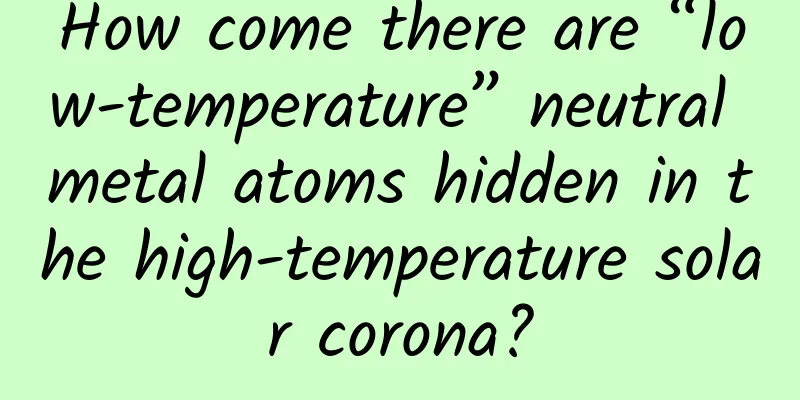How come there are “low-temperature” neutral metal atoms hidden in the high-temperature solar corona?

|
Produced by: Science Popularization China Author: Qu Zhongquan (Yunnan Astronomical Observatory, Chinese Academy of Sciences) Producer: China Science Expo Editor's note: In order to expand the boundaries of cognition, the China Science Popularization Frontier Science Project has launched a series of articles on the "Unknown Realm", which provides an overview of the exploration results that break through the limits in deep space, deep earth, deep sea and other fields. Let us embark on a journey of scientific discovery and get to know the amazing world. The sun is the closest star to us, and therefore the star that we humans can observe most comprehensively and carefully. Currently, there are devices in the sky (spaceborne solar telescopes), on the ground (ground-based solar telescopes), and even underground (such as solar neutrino detection) that can conduct uninterrupted long-term observations of the sun. Therefore, it is not easy to make new and important discoveries. The peculiar structure of the sun: the farther from the center, the lower the temperature Like our Earth, the Sun has a structure and is not a uniform ellipsoid. Figure 1 The sun is composed of the core, radiation layer, convection layer and atmosphere. The solar atmosphere is composed of the photosphere, chromosphere, transition zone and corona from the inside to the outside. (Image source: Institute of Optoelectronics Technology, Chinese Academy of Sciences) The outermost layer is the solar atmosphere, which also has a structure. From the inside to the outside, it consists of the photosphere visible to our naked eyes, the chromosphere invisible to the naked eye, the transition zone, and the corona (see Figure 1). The temperature at the center of the sun is as high as 15 million degrees. Thermonuclear reactions are taking place there, which is the most fundamental source of heat energy for the sun. The temperature continues to drop from the inside to the outside until it reaches the temperature minimum layer (zone) at the boundary between the photosphere and the chromosphere. At this time, the temperature increases abnormally as you go out . The temperature of the material near the temperature minimum layer (zone) of the photosphere is 5600 degrees or even lower, while the temperature of the chromosphere material above the photosphere gradually rises to tens of thousands of degrees. After passing through the extremely thin transition zone, the temperature rises sharply to over a million degrees in the corona. At the same time, the density of the solar atmosphere has been decreasing with altitude. The above is our human framework understanding of the structure of the sun that brings vibrant life to our Earth. However, since humans are currently unable to send equipment into the relatively dense interior of the solar atmosphere for direct measurements (in recent years, the U.S. Parker Solar Probe conducted detections in the outermost extended corona), all structures and physical properties of the solar atmosphere are determined by inferring solar electromagnetic radiation and high-energy particle detection data. For example, the above judgment on the high temperature of the corona was first made by people who recorded a green emission line of the corona during the total solar eclipse observation in the 19th century - the coronal green line (FeXIV530.3nm, thirteen-times ionized iron line, wavelength 530.3 nanometers). Decades later, based on the quantum theory of the origin of atomic and ion spectra, it was inferred that the temperature of the corona could be as high as one million degrees. The subsequent discovery of multiple coronal emission lines such as the red, yellow and blue lines strengthened the understanding of the high temperature of the corona. This is the basis for the textbooks' common belief that the temperature of the corona exceeds one million degrees. It goes against the "common sense" that the farther away from the center (core) of the sun, the lower the temperature. With the development of observation instruments, people gradually realized that the corona is composed of many plasmas (partially ionized or fully ionized gases) with different temperatures, but its temperature is not less than hundreds of thousands of degrees. For example, the observations of solar observation instruments carried by satellites in the sky, such as the various ultraviolet spectral imaging observations on the Solar Dynamics Observatory SDO/AIA and the X-ray telescope of China's Advanced Space-based Solar Observatory ASO-S, show that the temperature of the corona actually covers a certain range - from hundreds of thousands of degrees to millions of degrees, and even up to tens of millions of degrees when active. However, why the temperature of the solar atmosphere changes from a few thousand degrees in the photosphere to more than a million degrees in the corona has become one of the century-old puzzles in astrophysics. At present, the general view is that this peculiar phenomenon is caused by the existence of the solar magnetic field. Although solar physicists have proposed several possible mechanisms, the specific mechanism research is still in-depth. Our total solar eclipse observation is one of the many efforts. However, the above understanding of the temperature range of the corona has been challenged by the results of our analysis of total solar eclipse observation data. What are Fraunhofer lines? Before we go into more detail about how to determine the temperature of various parts of the corona, we need to understand what Fraunhofer lines are. As we all know, in the 17th century, the great British scientist Isaac Newton made solar radiation pass through a small hole and then used a prism to separate the seven-color parts of the sunlight (this process is now called dispersion, and the collection of various colors after separation is called a spectrum), and then synthesized the seven-color sunlight through an instrument to create white light. This proved that white light is composed of multiple colors of light. Figure 2 Dispersion experiment (Photo source: VEER Gallery) Unfortunately, Newton did not use narrow slits instead of pinholes to improve the dispersion ability of his spectroscopic prism. His compatriot Wollaston observed dark characteristic spectral lines in the solar rainbow spectrum in 1802. However, systematic observations were made by the German Fraunhofer in 1814, who discovered a total of 576 such spectral lines (see Figure 3) and correctly recognized that these spectral lines were produced by the absorption of background continuous radiation by elements in the solar atmosphere. Figure 3 The solar absorption spectrum recorded by Fraunhofer in 1814 (a large number of vertical black lines densely distributed in the picture). (Image source: ScienceNet) Therefore, the spectral lines with this characteristic were named Fraunhofer lines by later generations. According to the analysis of Fraunhofer lines based on physical principles, we can quantitatively determine the astrophysical properties. This discovery opened the door to astrophysics. With the continuous invention and creation of mankind, the records of solar Fraunhofer lines are becoming more and more detailed, or in other words, the spectral dispersion resolution ability is getting higher and higher. Figure 4 is the solar absorption spectrum with medium spectral resolution ability. Figure 4 Fraunhofer spectrum of the sun The rows of solar Fraunhofer (absorption) lines (each row of dark vertical short lines) recorded by the camera above are from the red region with longer wavelengths to the purple region with shorter wavelengths. It can be seen that these Fraunhofer spectral lines are much darker than the surrounding bright background without line segments - the continuous spectrum, that is, the radiation intensity is much smaller. (Image credit: NASharp, NOAO/NSO/Kitt Peak FTS/AURA/NSF) Generally speaking, the higher the resolution, the more mixed spectral lines can be separated, allowing us to see more spectral lines. Astronomers can use characteristics such as wavelength and compare the spectra obtained in Earth laboratories to identify which atoms or ions produce the spectral lines, and can determine whether these particles are in the ground state, excited state, or ionized state, thereby preliminarily determining the ambient temperature of the particles that produce the spectral lines. Just like steps, atoms or energy levels are also discontinuous. This is like a person climbing stairs, the higher the climb, the more energy is required. If the excitation or ionization of bound electrons outside the nucleus from the lowest energy state - the ground state to the excited state is produced by irregular thermal motion, then the higher the energy level, the higher the temperature required. It is precisely because the spectrum lines produced by the energy levels of hydrogen atoms are discontinuous that Bohr gave the quantum model of atoms. Furthermore, after the spectral lines are identified, we know that there are many physical reasons that can change the shape of these spectra (spectral line profiles). For example, the width of the spectral line core mentioned above can provide us with more quantitative temperature information. Astrophysicists quantitatively analyze the corresponding physical states based on these profile shapes and their changes. For example, the study of spectra - spectral diagnostics, can also infer the formation temperature of spectral lines from the width of the spectral line core. In fact, these Fraunhofer lines are mainly produced in the solar photosphere mentioned above, where the temperature is relatively low, with an average temperature of about 6000 degrees Celsius. Most of the solar atmospheric particles are in a neutral state there, that is, the electrons outside the nucleus of the atoms are not stripped away by the ionization process. However, paradoxically, as we move away from the core (heat source) of the sun and further out to the chromosphere, the temperature of these material particles not only does not decrease but increases, and most particles are in highly excited or ionized states that can only be reached at higher temperatures. More atoms or ions are in these unstable states, causing the electrons outside the nucleus to transition from high-energy states to low-energy states and produce emission spectral lines. At the same time, as the density of matter decreases, absorption decreases significantly with altitude, and there are more and more emission lines in the chromosphere, and they become stronger and stronger. In the transition zone and corona, the only spectral lines that can be observed under normal circumstances are emission lines (see Figure 5). The absorption lines in the upper half are compared with the emission lines in the lower half. The difference between them is that the radiation intensity of the absorption lines is less than the background continuous spectrum, while the intensity of the emission lines is higher than the continuous spectrum background radiation). Figure 5 Schematic diagram of absorption line (top) and emission line (bottom). The radiation intensity of the absorption line is less than the background continuous spectrum intensity, while the emission line intensity is higher than the continuous spectrum background radiation. In the figure above, the wavelength increases from left to right in nanometers. (Image source: ScienceNet) Based on the above, it is not difficult to infer that even for the same spectral line, the temperature required to produce the emission line is higher than that of the absorption line, because it is a downward transition from a high energy level to a low energy level. It should also be noted that during the total solar eclipse observation, people observed a faint Fraunhofer line at the beginning of the last century. This spectral line is produced by the scattering of the solar photosphere Fraunhofer line by dust that is more than two million kilometers above the edge of the sun and is distributed in an ellipsoidal shape around the sun. Therefore, this part of the radiation is called the Fraunhofer corona, or F-corona for short. It is worth noting that if these dusts are too close to the photosphere, they will be sublimated into a plasma state by solar radiation and heat. The outermost part of the F-corona is associated with the zodiacal light we observe. Our discovery of neutral metal atoms in the inner corona at an altitude of tens of thousands kilometers above the edge of the Sun challenges the currently popular coronal composition and temperature distribution. Dark cold matter discovered in the inner corona of the Sun The Fiber Array Solar Telescope (FASOT) team of Yunnan Observatory of the Chinese Academy of Sciences is committed to developing FASOT, which is evaluated by the authoritative international solar physicist JOStenflo as opening the door to a new type of solar observation equipment. With the support of the National Natural Science Foundation of China and the Joint Key Fund of Astronomy of the Chinese Academy of Sciences, a small FASOT prototype was successfully developed in early 2013. In order to detect the physical properties of the outermost atmosphere of the sun, the corona, the group organized joint Sino-British total solar eclipse observations in Cairns, Australia in December 2012 and in Bifung, Gabon in July 2013 with Durham University in the UK. The purpose was to use the FASOT prototype to be the first in the world to realize polarization spectrum imaging of coronal emission lines and chromospheric emission lines (blaze spectrum) to reveal new physical properties of the corona. Afterwards, the FASOT prototype was carried out in the United States in 2017 and Chile in 2019 to conduct more in-depth and complex observations to unravel the mystery of the occurrence and development of many corona phenomena. After receiving funding from the "Fiber Array Solar Optical Telescope FASOT Development", a major national scientific research instrument development project established by the National Natural Science Foundation of China, the FASOT prototype was successfully developed in July 2024. The latter will obtain three-dimensional and precise information on the real-time magnetic field vector, thermodynamic and kinetic quantities of the solar multi-layer atmosphere. When analyzing the data obtained in the observation band (516.3-531.6nm) during the total solar eclipse in Gabon, Africa on November 3, 2013, it was unexpectedly discovered that Fraunhofer lines corresponding to these emission lines were also observed in the regions where some neutral metal atomic emission lines are formed (chromosphere and transition zone) (see Figure 6). Figure 6: Raw polarization spectrum data collected by the FASOT prototype during the 2013 total solar eclipse in Gabon, Africa (not yet demodulated). Upper image: Above the region where emission lines (vertical bright lines) are generated, there are also Fraunhofer lines (vertical dark lines in the image), and they coexist with the million-degree high-temperature spectrum line - the coronal green line (the widest vertical bright emission spectrum line on the right) in the visual projection area. Lower image: For comparison, in the inner corona, there are only emission lines but no Fraunhofer lines. As can be seen from the image, Fraunhofer lines are much darker than emission lines. (Image credit: FASOT team) The analysis of this data shows that there are neutral metal atoms (iron Fe, magnesium Mg, chromium Cr and titanium Ti, etc.) in the corona within an altitude of 30,000 kilometers above the solar photosphere. These neutral atoms scatter the photospheric absorption (Fraunhofer) spectral lines and are detected by us. Their excitation potential is less than 3eV (electron volt), and the corresponding temperature is less than 25,000 degrees. Judging from the Doppler broadening of the spectral lines caused by factors such as temperature, the temperature of some neutral particles can be close to the typical photosphere temperature of 6,000 degrees. Therefore, compared with the millions of high temperatures of other particles in the corona, these neutral particles can be called cold matter. In addition, compared with the coronal green line radiation detected in the same line of sight projection area at the same time, the Fraunhofer line radiation scattered by these neutral atoms is much dimmer (see Figure 6). If the properties of the corresponding absorption (Fraunhofer) lines above the region where the metal atomic emission lines are formed are not considered, there are two possible reasons for their generation. Either dust scattering is observed through the projection effect or there are neutral metal atoms in the inner corona that scatter the Fraunhofer lines of the photosphere. However, after analysis, we find that the observed Fraunhofer lines have the following properties: 1) Its linear polarization degree is much smaller than the theoretical and observed values previously deduced by most researchers based on dust scattering. This indicates that the particles that produce the scattering are in the inner corona; 2) The relative intensities between them and the relative intensities of the corresponding Fraunhofer lines in the photosphere have changed greatly. Some absorption lines are stronger than other lines around them, while in the photosphere it is just the opposite. The relative intensities between the spectral lines scattered by dust and the relative intensities between the Fraunhofer lines in the photosphere remain unchanged; 3) The wavelength shifts of the center of the spectral lines of different neutral particles produced by the Doppler effect are different. This shows that these atoms are not gathered in the dust and have the same relative speed, but are dispersed from each other and move independently. The properties of the Fraunhofer lines detected from the above three points can rule out dust scattering and determine that they are produced by scattering of relatively independently moving neutral metal atoms in the inner corona. What does the discovery of dark, cold matter in the solar corona mean? The above discovery has changed our understanding of the composition of the solar corona. This discovery shows that in addition to the high-temperature, fully ionized free electrons and ions in the solar inner corona, there are also low-temperature neutral metal atoms. These neutral atoms emerge from the photosphere and escape the heating of the chromosphere and transition region. This puts constraints on the distribution of the heating sources in the chromosphere and transition region: these heating sources do not play a heating role in all these spaces at all times. It should be noted that the corona is still mainly composed of high-temperature materials ranging from hundreds of thousands to millions of degrees. According to the total solar eclipse observations in Timor-Leste in April 2023 organized after this discovery, these dark cold materials account for less than one percent of the total material density in the observation space. However, this very small proportion may play an important role in revealing the mystery of coronal heating. First, these dark cold substances are extremely rare and will not lower the temperature of the coronal substances, but will raise the temperature of the substances around them and themselves. The reason is that the basic structure of the corona is coronal loops of different sizes. Most of the substances in the corona (ions and free electrons) move in a spiral around the axis of the magnetic loops, just like cars (free electrons) and trucks (ions) passing in an orderly manner on a highway. The coronal magnetic loops can be regarded as part of a closed circuit, and the resistance of this part is close to zero when there are no neutral atoms. However, once a small number of neutral atoms that are not bound by the magnetic field rise from the photosphere to the coronal loops, they will collide with these moving ions and free electrons, which can increase the resistance of this circuit by a million times. This mechanism of resistance mutation is called Cowling conduction. It is like a serious traffic accident caused by falling rocks blocking a section of a highway. At this time, Joule dissipation in the magnetic loop will release the energy of the current in the form of heat, heating these neutral particles, ions and free electrons. There is more dark cold matter in the inner corona, and research will continue The dark cold neutral metal atoms detected in the inner corona only exist in local areas. Are there more dark cold neutral metals in the inner corona, or is the entire inner corona filled with sparse dark cold metal atoms? This question needs to be answered through observation. In fact, it was to answer this question that the FASOT team organized the observation of the total solar eclipse in East Timor on April 8, 2023. The observation instrument became a small twin telescope that can image a large area of the corona. We use these observation equipment to achieve simultaneous observations in the same space but in two different bands. Preliminary analysis results show that the results obtained by integrating the observation data in the two bands of 659.4nm and 660.1nm are that dark cold matter can be distributed in most areas of the inner corona. In the future, we will use observations in more bands to calculate the density and distribution of dark cold matter in the inner corona, so as to fully grasp the physical properties of the inner corona and try to solve the century-old problem of coronal heating. References 1.Markus J. Aschwanden, Physics of the Solar Corona, an introduction, 2005, Springer, Praxis-Publishing, ISBN:3-540-22321-5 2.ZQ Qu, L. Chang, GT Dun, et al., 2024, Spectropolarimetry of Fraunhofer Lines in Local Upper Solar Atmosphere, the Astrophysical Journal, 974:63 |
Recommend
What is the difference between programmatic and custom creatives in Toutiao’s information flow?
With the launch of information flow, many friends...
Essential for lazy people: multiple pull-down refresh, pull-up to load more, and configure custom header ad space library
Introduction Developers can use BGARefreshLayout-...
Apple suddenly changed its attitude! It completely stopped updating iOS 14 and pushed iOS 15: The response is hard to accept
When iOS 15 was officially released, Apple provid...
Some nouns become cute when the word "small" is added to them. What about a hydroelectric power station?
Produced by: Science Popularization China Author:...
What is a good product and how can a good product make money for a company?
Any business model and product that is not aimed ...
In addition to BYD Xia, there is also Xiaomi SU7 Ultra. The popular new cars of 2025 are coming. Which one is your favorite?
In the automotive market, no one fights an unprep...
Seahorse dad can "give birth"
They are the only species where males give birth ...
India is experiencing a temperature of nearly 50 degrees, and even mosquitoes have disappeared! What will happen to people?
Recently, "India has seen a temperature of n...
How can SEO novices write a good TKD?
Student asked: What is TKD? Teacher’s answer: TDK...
9 ways to monetize short videos, how many do you know?
Creators often encounter similar problems when ma...
4 big mistakes that Jack Ma has made over the years
Recently, Jack Ma brought 1.2 billion yuan to Ever...
2023, go to the beach!
New Year You should go to the beach. From North t...
Can my iPhone X last another 3 years?
Whether you buy an iPhone 11 or an iPhone X, the ...
Dual-engine drive to analyze JD.com's ambition to become an international smart company
"Don't miss out on the Chinese market wi...
20 new tricks Facebook is using to eat up the Internet: Do you want to learn from them?
Facebook is most afraid of users leaving. It keep...









